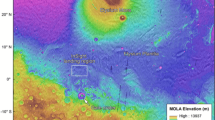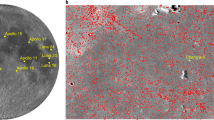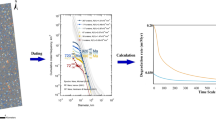Abstract
The first part of the paper describes the relationship between the erosional stage of craters and the crater areal density. It is shown that class-2 and -3 craters are progressively more abundant as the crater areal density increases, while craters of class 4 and 5 are more abundant with decreasing crater areal densities. A geological model is proposed, in which the class of a newly foormed crater is 1. As time progresses, erosional agents will increase the class of the crater to class 2, then 3, and, in some cases, to 4. The length of time between classification steps is not known in terms of years, but is equivalent to the time necessary for the crater density to increase by 2 to 8 craters per unit area for creaters larger than 10 km, and by 10 to 20 for craters larger than 3.5 km. Craters of class 5 and some of class 4 are not formed by the same erosional agents, but are catastrophic, caused either by a mare-producing impact or by ‘flooding’ of mare material.
The second part of the paper presents a method for relatively dating large lunar areas. The method uses the model previously developed. A relative time sequence is constructed using the density of craters of classes 1, 2, and 3 and the percentage of these which is of class 1. As an example, 18 large areas are defined on the lunar near side and are put in temporal order. Mare Serenitatis appears to have the youngest terrain, and an area southwest of the Rupes Altai appears to have the oldest.
In the final part of the paper a geological model is developed in order to explain age differences in the terrae. The model calls for ‘rejuvenation’ of lunar terrains, caused by the seismic waves and ballistic sedimentation resulting from large impacts. The area surrounding Mare Orientale is cited as an example of a terrain so affected. A similar effect on the terrae of the near side could explain the apparent age relationships measured.
Similar content being viewed by others
References
Arthur, D. W. G., Agnieray, A. P., Horvath, R. A., Wood, C. A., andChapman, C. R.: 1963, ‘The System of Lunar Craters, Quadrant I’,Commun. Lunar Planet. Lab., Univ. of Arizona 2, pp. 1–60.
Arthur, D. W. G., Agnieray, A. P., Horvath, R. A., Wood, C. A., andChapman, C. R.: 1964, ‘The System of Lunar Craters, Quadrant II’,Commun. Lunar Planet. Lab., Univ. of Arizona 3, pp. 1–59.
Arthur, D. W. G., Agnieray, A. P., Pellicori, R. H., Wood, C. A., andWeller, T.: 1965, ‘The Systems of Lunar Craters, Quadrant III’,Commun. Lunar Planet. Lab., Univ. of Arizona 3, pp. 1–146.
Arthur, D. W. G., Pellicori, R. H., andWood, C. A.: 1966, ‘The System of Lunar Craters, Quadrant IV’,Commun. Lunar Planet. Lab., Univ. of Arizona 5, pp. 1–208.
Guest, J. E. andFielder, G.: 1968, ‘Lunar Ring Structures and the Nature of the Maria’,Planetary Space Sci. 16, 665–673.
Kopal, Z.: 1968, ‘The Erosion on the Lunar Surface’, Boeing Scientific Research Laboratories Document D1-82-0734.
Offield, T. W. andPohn, H. A.: 1968, ‘Lunar Crater Morphology and Relative Age Determination’ (abstract),The Geol. Soc. of America, 64th Annual Meeting Univ. of Arizona, p. 89.
Ronca, L. B.: 1968, ‘On the Distribution of Large Lunar Craters’,Icarus 9, 197–211. Also Boeing Sc. Res. Lab. Document D1-82-0697.
Ronca, L. B. andGreen, R. R.: 1968, ‘Surface Density of Large Lunar Craters’,Nature 218, 1147–1149.
Shoemaker, E. M., Hackman, R. S., Eggleton, R. E.: 1963, ‘Interplanetary Correlation of Geologic Time’,Advances in Astronautical Sciences 8, 70–89, Plenum Press, New York.
Author information
Authors and Affiliations
Rights and permissions
About this article
Cite this article
Ronca, L.B., Green, R.R. Large-scale evolution of the lunar surface. Astrophys Space Sci 3, 564–578 (1969). https://doi.org/10.1007/BF00704861
Received:
Issue Date:
DOI: https://doi.org/10.1007/BF00704861




